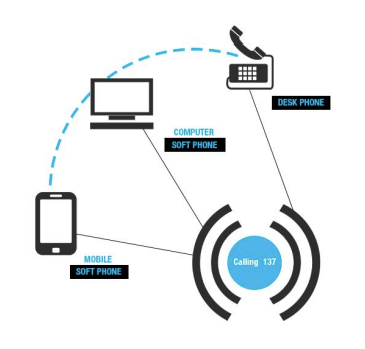How To Grow Your PBX Sales?
Customers will be impressed how Unified Communications, especially if they OWN the system vs. paying a monthly per phone fee to a third-party company, can play an important role in boosting productivity by offering greater mobility, enabling collaboration and saving employees’ time.
With features such as presence, soft-phones, and video conferencing, employees can use their time more productively and communicate with their colleagues and customers more easily. Having full control of their communications will be especially important as we enter a world were AI will become more and more important. (Separate article on this in relationship to IPTECHVIEW to come soon.)
Introduction
Business phone systems and communications solutions have come a long way in the past decade, in particular with the shift towards IP-based solutions offering UC features. As more companies look to move away from their old proprietary phone systems towards such solutions, the demand for Unified Communications (UC) features has grown. To explain the core value of unifying management of all communications in one platform to your customers is one of the key concept that will help you boost your sales.
Recent research from Software Advice shows, 76% of small and medium sized-businesses are interested in purchasing a UC solution (Software Advice, 2014). One of the key reasons driving the adoption of UC solutions is the productivity gains which can be achieved, for all sizes and types of organizations. Thanks to Unified Communications it is now possible for employees to participate in a web conference when working from home, receive voicemail messages to their email when traveling, and see whether their colleagues are available to take calls. What’s more, UC applications are becoming increasingly sophisticated, the usage of SMS is growing and another trend which is set to increase at an even faster pace with the emergence of WebRTC. WebRTC technology, enables video and voice communications to take place through the internet browser, adding a new dimension to Unified Communications. It means people can do all these things with any device they choose. From smart phone to desk phone, laptop to conference room. This white paper will explain how Unified Communications can play an important role in boosting productivity by offering greater mobility, enabling collaboration and saving employees’ time.

What is Unified Communications?
Unified Communications is the integration of voice, video and data into one solution, allowing users to be in touch with anyone, wherever they are, and in real time. UC features include: instant messaging, presence information, video conferencing, and unified messaging. For businesses and other organizations, adopting a UC solution eliminates the need for multiple communications systems. In turn this optimizes business procedures and boosts communications by simplifying processes, making it easier for people to keep in touch.
How can Unified Communications Increase Productivity?
As businesses and organizations look to updating their communications solutions, Unified Communications can play an important role in boosting productivity and efficiency by offering greater mobility, boosting collaboration and saving employees’ time.
a. Enjoy Greater Mobility
 Mobility in the workplace has become an increasingly important topic within recent years. In a survey from InformationWeek the need to create a more mobile workforce was cited as the second most popular reason for adopting UC (InformationWeek, 2014). Offering employees greater mobility and the ability to work at home is also linked to increased productivity and greater job satisfaction.
Mobility in the workplace has become an increasingly important topic within recent years. In a survey from InformationWeek the need to create a more mobile workforce was cited as the second most popular reason for adopting UC (InformationWeek, 2014). Offering employees greater mobility and the ability to work at home is also linked to increased productivity and greater job satisfaction.
However, with the rise of remote workers and the increase number of companies using hot desking, employees need to be able to answer their desk phone from a variety of devices and from wherever they are working. UC enables greater mobility in a number of ways, including the one number concept and the provision of softphones.
With the one number concept employees are able to answer their deskphone from a softphone on their PC, smartphone or tablet from wherever they may be working. Employees no longer need to give out their office mobile number, or worse their personal number because they can take their phone number with them. Considering that 60% of workers carry out work communications outside office hours the one number concept is extremely useful (Ofcom, 2014). This feature is also useful for businesses which use hot desking as it allows employees to move around the office, rather than being tied to a fixed handset.
Softphones are another key feature of UC solutions which enable mobility. Softphones are software applications which allow voice and video calls to be made over the internet. With softphone clients for Windows, Mac, Android and iOS, employees can answer their office calls even when they are away from their desk on their PC, smartphone or tablet.
With nearly three out of every four organizations issuing corporate-owned laptops and smartphones to their workforces and others implementing ‘Bring Your Own Device’ (BYOD) policies, connecting employees with UC has great potential (Frost & Sullivan, 2014). However, it is important that businesses choose a solution which offers reliable clients for all the different operating systems.
Case study: Research conducted by Stanford University in conjunction with C-Trip, a discount travel website in China, found that productivity increased when they allowed 250 of their call centre employees to work from home. Productivity among the teleworkers rose by 13%9.5%. One-third of this increase was due to having a quieter working environment, while the other two-thirds was due to the fact that people worked more hours. What’s more, from the employee’s perspective job satisfaction increased (Harvard Business Review, 2014).
b. Communicate More Effectively
One the most cited benefits of Unified Communications is the presence feature. Knowing where your intended recipients are and whether they are available in real time offers great benefits for businesses.
By being able to view others’ presence information saves time and avoids unnecessary call transfers. If for example you want to transfer a client call to an extension, you can first check and see if that extension is busy and then make the transfer, or transfer it to another extension. This feature is also practical for businesses with multiple offices or for those with remote workers, where it is not possible to physically see whether the person is in the office or available to speak.
The presence feature also allows employees to inform their colleagues about their current status and controls how their calls are handled. For instance, if you are in a meeting you can set your status to away so that calls will be automatically diverted to another extension or to your voice mail. This helps employees communicate more efficiently, thereby increasing productivity. Research shows that half of the companies using a presence feature ‘reported fewer repeated messages, or ‘telephone tag’ with many employees saving as much as three hours per week, or 150 hours per year. With the average U.S. worker earning about $35 per hour, an office with 25 employees can recover more than $130,000 in productive work time annually’ (Cisco Systems).
Another useful feature provided by UC solutions is the ability to convert inbound faxes into PDF format and forward them to a user’s email, without requiring any additional fax server software. Likewise voicemails can be converted to sound files and forwarded via email. This increases productivity by ensuring that employees always have the most up-to-date information there is nothing worse than missing an important message from a colleague or customer.
Case study: Horizon Housing, based in Queensland, Australia, manages and develops community and affordable housing for people on low to moderate incomes by providing them with high quality and sustainable housing solutions. Horizon Housing found that adopting a UC solution has boosted productivity and improved communications. The ability to answer their office line on their mobile phone has enabled staff to remain connected, even when they are out of the office visiting properties and meeting tenants. Using the real time presence information it is now possible to track when staff are available to take calls, meaning that communication within the company can be managed more effectively (3CX, 2014).
c. Boost collaboration with colleagues and customers
 Unified Communications features can boost collaboration within businesses by enabling employees to interact more easily across different mediums. Research from InformationWeek shows that 62% of businesses said that improved employee collaboration is a top business driver for UC (InformationWeek, 2014). Features which improved business collaboration include: video conferencing and instant messaging.
Unified Communications features can boost collaboration within businesses by enabling employees to interact more easily across different mediums. Research from InformationWeek shows that 62% of businesses said that improved employee collaboration is a top business driver for UC (InformationWeek, 2014). Features which improved business collaboration include: video conferencing and instant messaging.
With a software-based UC solution it is now possible to setup video conferences with a few clicks and collaborate with colleagues or customers around the world. Moreover, video conferencing can cut the cost and time spent on business travel, making a significant difference to business overheads. With the emergence of WebRTC technology, as explained below, video conferencing is set to become even more flexible.
Visual collaboration can provide a valuable and effective way of communicating with customers and suppliers, enabling businesses to give product demonstrations and pitches. Being able to discuss face-to-face, in contrast to impersonal conference calls, can boost creative collaboration and enable business to make faster decisions. Nonverbal communication and visual interaction can help create successful conversations.
Instant messaging is another helpful UC feature for businesses. The informality and speed of instant messaging allows employees to share their thoughts more easily and cuts down on unnecessary internal emails. Instant messages can enable more productive collaboration, particularly when brainstorming ideas. Another key benefit of instant messaging is the ability to see a colleague’s presence status. With email, on the other hand, you have no indication of whether a person is at their desk or how long it will take for a response.
The Future of Unified Communications WebRTC
 Unified Communications applications are becoming increasingly sophisticated, particularly with the emergence of WebRTC. WebRTC technology, enables video and voice communications to take place through the internet browser, meaning that users can join web conferences or make calls without the need to download any additional software or plugins. By the end of 2019 more than 2 billion people and 6 billion devices are expected to use and support WebRTC (Disruptive Analysis, 2014).
Unified Communications applications are becoming increasingly sophisticated, particularly with the emergence of WebRTC. WebRTC technology, enables video and voice communications to take place through the internet browser, meaning that users can join web conferences or make calls without the need to download any additional software or plugins. By the end of 2019 more than 2 billion people and 6 billion devices are expected to use and support WebRTC (Disruptive Analysis, 2014).
WebRTC is a game changer for Unified Communications, offering simpler and cheaper realtime communications options . WebRTC brings all of the plusses of enterprise video multitasking and collaboration, less travel for inperson meetings without the costly infrastructure and human resources investment. By removing the need for a client, WebRTC will also push expensive proprietary UC vendors from the market.
WebRTC goes beyond VoIP and web conferencing, providing click-to-call capabilities, as seen with Amazon’s Mayday button. With just one click website visitors can make a free voice or video call directly to a business through the internet browser. When a visitor clicks on the embedded call button in a website, a VoIP call will be made and can be immediately answered by the right person within the business. As a result customer satisfaction will increase along with sales and productivity.
Recommendations for Selecting a Top UC Solution
➔ Identify your short term and long terms communication needs to ensure that you choose a solution which supports all the UC features your business requires.
➔ Avoid being locked into a proprietary system choose an open standards solution. Open standards allow you to mix and match your handsets, VoIP provider, and gateway to build the best solution for your business.
➔ Check which UC features are included as standard with the solution as some vendors will charge extra for certain features.
➔ Ensure that the solution includes secure and easy-to-use phone clients for all operating systems to enable your workforce to enjoy full mobility.
➔ WebRTC is set to revolutionize the UC market make sure your vendor is committed to innovation and adopting this technology.
➔ Choose a solution which offers fully integrated, multiple-participant video conferencing to boost collaboration within your business.
➔ Select a software-based solution which can be easily integrated with your existing IT infrastructure and CRM applications.
Conclusion
Businesses which have implemented the latest UC solutions are able to achieve improved productivity and efficiency savings by communicating more effectively internally and externally with their colleagues and customers. With features such as presence, softphones, and video conferencing, employees can use their time more productively and communicate with their colleagues and customers more easily. UC solutions are set to become increasingly sophisticated with the growth in adoption of WebRTC technology.
Before implementing a UC solution businesses should consider their overall communications strategy. A corporate UC solution is an investment for the future a high quality vendor will provide a fully functional, secure communications system which will increase productivity and create a professional appearance. 3CX Phone System is a software-based solution packed full of UC features, including all those described in this whitepaper. In addition, 3CX offers a fully integrated web conferencing solution, 3CX WebMeeting, which is one of first multiple participant web conferencing solutions utilising WebRTC. Designed with the IT administrator in mind, 3CX Phone System is easy to install and manage and can cut call costs by up to 70%.
References
● 3CX, April 2014: ‘Horizon Housing at home with 3CX Phone System’ [http://bit.ly/1CGXrp1]
● Cisco Systems: ‘Empowering Small and Field Offices with IP Communications’ [http://bit.ly/10m5SIz]
● Disruptive Analysis, September 2014: ‘WebRTC Market Status & Forecasts’ [http://bit.ly/1x1q6C3]
● Frost & Sullivan, March 2014: ‘The Future of Mobile Devices from a Customer PerspectiveUnited States and Europe’ [http://bit.ly/1oCYU7y]
● Harvard Business Review Nicholas Bloom, JanFeb 2014: ‘To Raise Productivity, Let More Employees Work from Home’ [http://bit.ly/1E3eX8u]
● InformationWeek, April 2014: ‘State of Unified Communications Report 2014’ [http://ubm.io/1oCWGoA]
● Ofcom, August 2014: ‘The Communications Market Report 2014’ [ http://bit.ly/1pHGZf7]
● Software Advice, August 2014: ‘Software Advice BuyerView: VoIP Software Report 2014: Insight into today's small-business software buyer'







